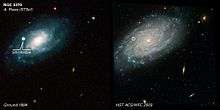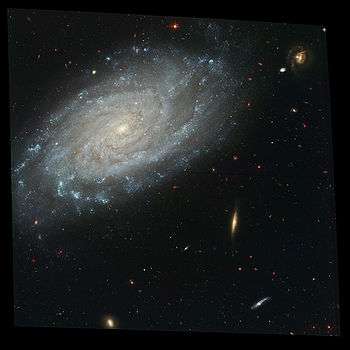NGC 3370
| NGC 3370 | |
|---|---|
|
| |
| Observation data (J2000 epoch) | |
| Constellation | Leo |
| Right ascension | 10h 47m 04.0s[1] |
| Declination | +17° 16′ 25″[1] |
| Redshift | 1279 ± 4 km/s[1] |
| Distance | 98 Mly |
| Apparent magnitude (V) | 12.3[1] |
| Characteristics | |
| Type | SA(s)c[1] III |
| Apparent size (V) | 3′.2 × 1′.8[1] |
| Notable features | Dusty |
| Other designations | |
| UGC 5887,[1] PGC 32207, Silverado Galaxy | |
NGC 3370 (also known as UGC 5887 or Silverado Galaxy[2]) is a spiral galaxy about 98 million light-years away in the constellation Leo. It is comparable to our own Milky Way both in diameter (100,000 light years) and mass (1011 solar masses). NGC 3370 exhibits an intricate spiral arm structure surrounding a poorly defined nucleus.
History
NGC 3370 was likely discovered by William Herschel, who provided it with the designation II 81.[3] His son John later designated it 750. William Herschel cataloged I 80 to NGC 3348[3] before and II 82 to NGC 3455 after NGC 3370.[3]
The object has a surface brightness of 13 and a position angle (PA) of 140°.
On November 14, 1994, S. Van Dyk and the Leuschner Observatory Supernova Search discovered a supernova in NGC 3370 at 10h 44m 21.52s +17° 32′ 20.7′′, designated SN 1994ae.[4] SN 1994ae was a type Ia supernova, and one of the nearest and best observed since the advent of modern digital detectors.[5] The maximal light of the supernova was estimated to have occurred between November 30 and December 1, peaking at visual magnitude 13.[4]

See also
- New General Catalogue (NGC)
- NGC 1365, spiral galaxy
External links
- HST: Celestial Composition
- Ho et al., BVRI Photometry of Supernovae
- NGC 3370 at ESA/Hubble
- NASA Astronomy Picture of the Day: Spiral Galaxy NGC 3370 from Hubble (12 October 2008)
References
- 1 2 3 4 5 6 7 "NASA/IPAC Extragalactic Database". Results for NGC 3370. Retrieved 2006-11-25.
- ↑ Sparrow, Giles (2006). Cosmos. Booksales. ISBN 1-905204-29-9.
- 1 2 3 William Herschel's Deepsky Objects (The Herschel 2500 list)
- 1 2 A Look at NGC 3370 in Detail
- ↑ "Celestial Composition". Hubble Space Telescope. ESA/Hubble. Archived from the original on 6 July 2015. Retrieved 6 July 2015.
